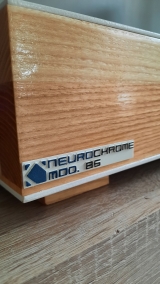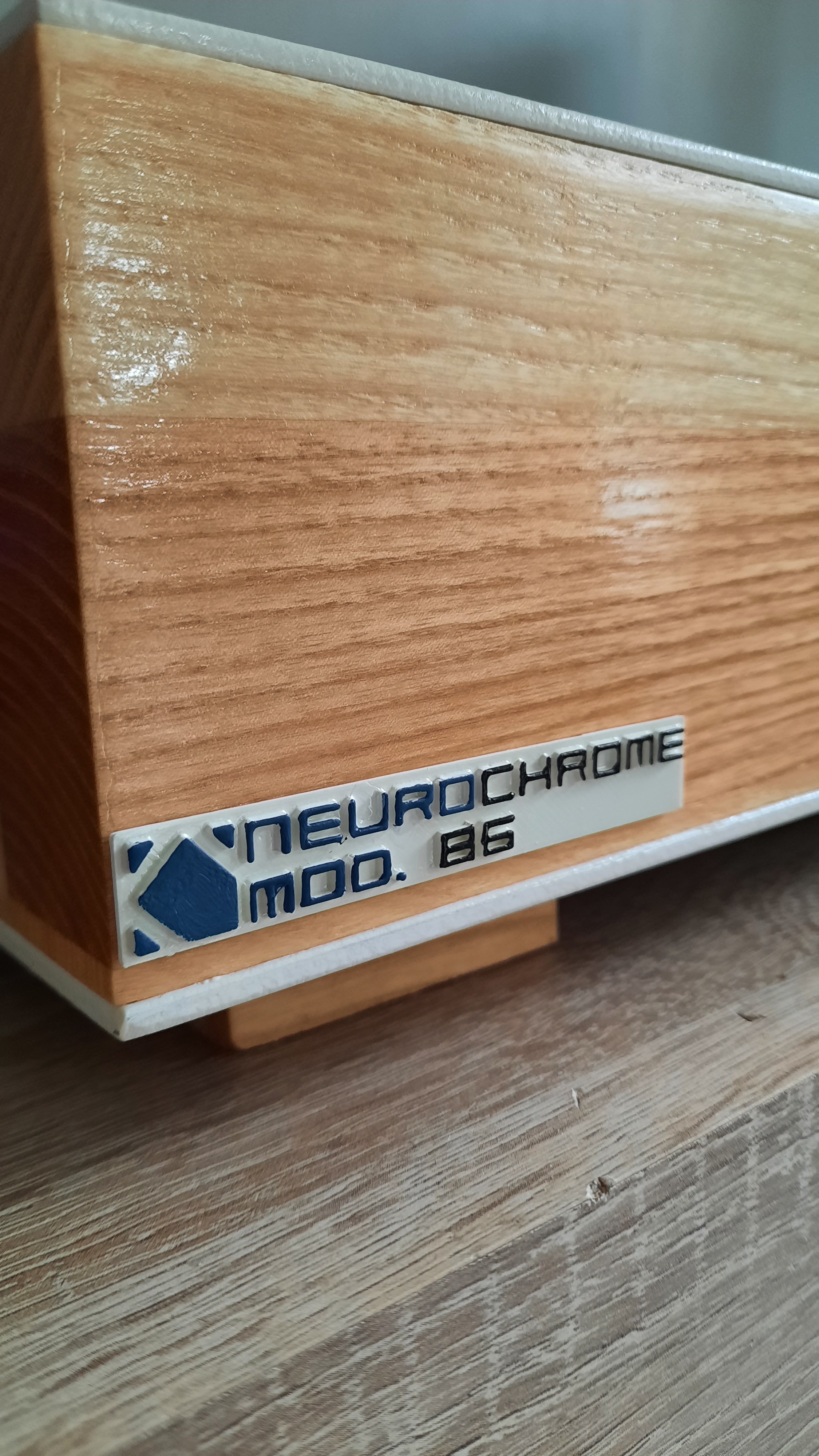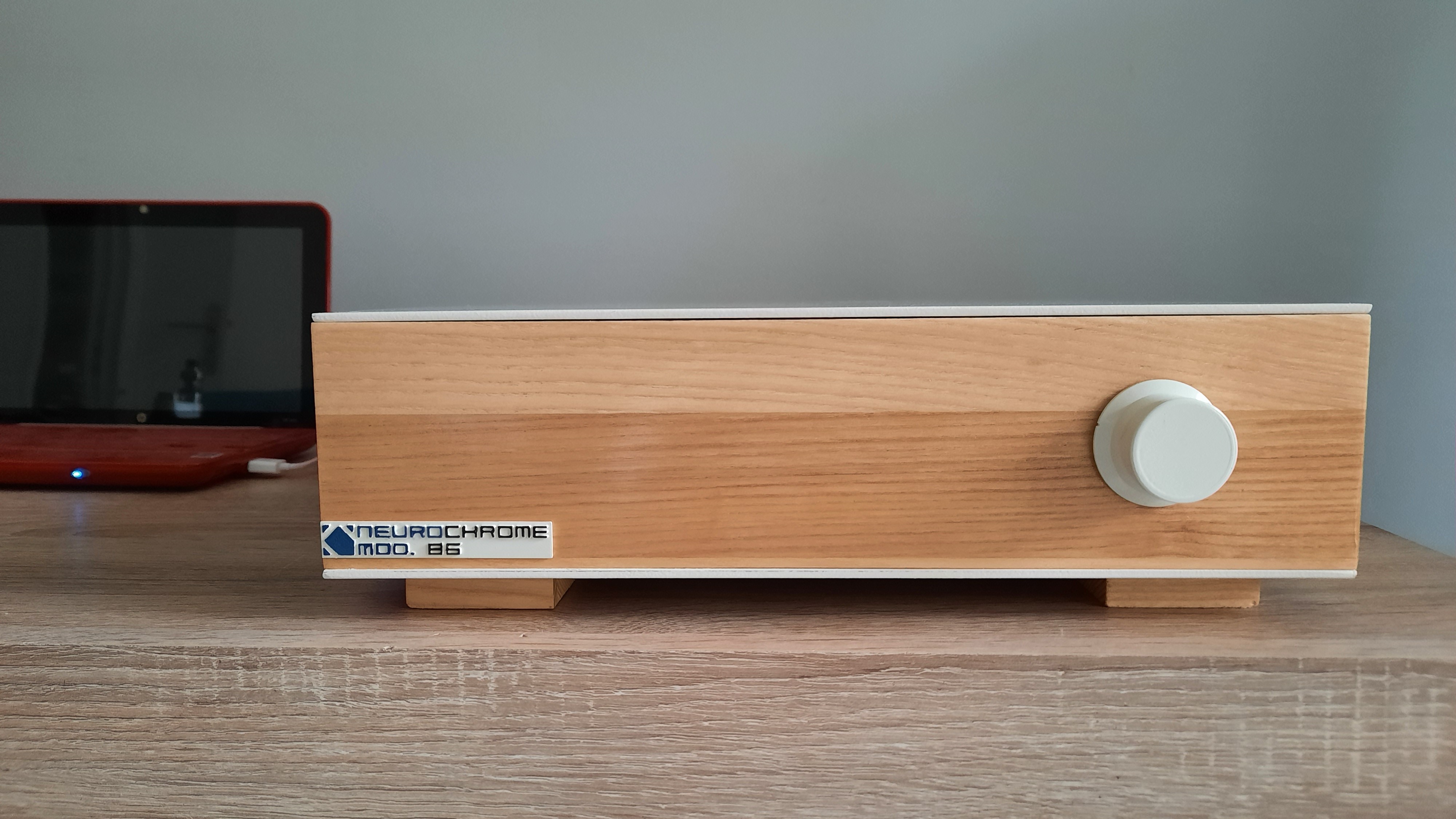I ordered two Mod-86 boards and two Power-86 boards (and a universal buffer for a separate preamp project). The boards are already shipped, nice! I finished an LM3886DR amp a few weeks ago (https://www.diyaudio.com/forums/chip-amps/295665-neurochrome-lm3886dr-build-49.html#post6517214), and I like it so much that it would be allowed to stay in my living room for years. The building and learning process was so enjoyable however that I want to keep busy. I want to expand on this new hobby, although it's daunting at times. Especially the theoretical stuff, I don't have a background in electronics and I'm weak at math so the more theoretical aspects are too difficult at this time. I bought some high school math books as a starting point.
Today, two nice Fischer heat sinks arrived that I originally intended for the LM3886DR (SK 627 50 SA FISCHER ELEKTRONIK - Heatsink: extruded | grilled; black; L: 50mm; W: 160mm; H: 82mm; SK627/50/SA | TME - Electronic components). I got impatient and bought an alternative that was in stock at Audiophonics. Good call, as I've been enjoying music for the last weeks already. The plus side is that I now have two even nicer heat sinks available for my new Mod-86 build.
The intention is to build two Mod-86 mono blocks. Mainly because I just like the idea, but I'm not 100% sure about this yet. Sonically and electrically there shouldn't be much difference, if any. Case work is a time intensive part of the building process, so a nice setup in a single case is attractive too.
This thread shows a case with wooden sides and metal bottom and top panels. It looks very nice. I was wondering about not having a full faraday cage however, as I understand that the chassis is connected to ground, causing it to act as an RF shield much like the shield in interconnect cables. Realistically, would there be a disadvantage if you don't have metal sides? An alternative would be to get a full metal chassis from Hammond or Modushop and mill a nice wooden front panel for it.
The design document for the Mod-86 doesn't list a table for the crest factor of the transformer explicitly like in the LM3886DR design document. With the LM3886DR I went for the recommended crest factor of 14dB because I listen to all kinds of music. For the Mod-86, will the recommended ±30V supply voltage result in a 14dB crest factor?
For caps for the Power-86 boards, I'm looking at some large Mundorf power caps. I want to do this build nicely and not skimp on anything, so I wouldn't mind getting more expensive caps, and it probably doesn't hurt. Reading about the performance of the Mod-86 though, I'm wondering if I should just save some serious money on this and get the large Cornell Dubilier caps like I used in the LM3886DR. No sense in wasting money on expensive parts if it doesn't make an audible or measurable difference.
Today, two nice Fischer heat sinks arrived that I originally intended for the LM3886DR (SK 627 50 SA FISCHER ELEKTRONIK - Heatsink: extruded | grilled; black; L: 50mm; W: 160mm; H: 82mm; SK627/50/SA | TME - Electronic components). I got impatient and bought an alternative that was in stock at Audiophonics. Good call, as I've been enjoying music for the last weeks already. The plus side is that I now have two even nicer heat sinks available for my new Mod-86 build.
The intention is to build two Mod-86 mono blocks. Mainly because I just like the idea, but I'm not 100% sure about this yet. Sonically and electrically there shouldn't be much difference, if any. Case work is a time intensive part of the building process, so a nice setup in a single case is attractive too.
This thread shows a case with wooden sides and metal bottom and top panels. It looks very nice. I was wondering about not having a full faraday cage however, as I understand that the chassis is connected to ground, causing it to act as an RF shield much like the shield in interconnect cables. Realistically, would there be a disadvantage if you don't have metal sides? An alternative would be to get a full metal chassis from Hammond or Modushop and mill a nice wooden front panel for it.
The design document for the Mod-86 doesn't list a table for the crest factor of the transformer explicitly like in the LM3886DR design document. With the LM3886DR I went for the recommended crest factor of 14dB because I listen to all kinds of music. For the Mod-86, will the recommended ±30V supply voltage result in a 14dB crest factor?
For caps for the Power-86 boards, I'm looking at some large Mundorf power caps. I want to do this build nicely and not skimp on anything, so I wouldn't mind getting more expensive caps, and it probably doesn't hurt. Reading about the performance of the Mod-86 though, I'm wondering if I should just save some serious money on this and get the large Cornell Dubilier caps like I used in the LM3886DR. No sense in wasting money on expensive parts if it doesn't make an audible or measurable difference.
The numbers given in the Modulus-86 design doc for "music signal" assume a 14 dB crest factor.
Those heat sinks would be excellent. The data sheet lists the thermal resistance as 0.8 K/W for 50 mm length.
It's always better with a metal chassis. But you can always line wood sides with metal foil or mesh. An alternative is to use an ugly (but cheap) metal box and line it with some nice panels of either wood or metal. Hammond has plenty of boxes in that category.
The power supply caps won't make much of a difference. I'd use a quality cap and use as much capacitance as you can fit in the board. The caps need to be 50 V rated or higher.
Tom
Those heat sinks would be excellent. The data sheet lists the thermal resistance as 0.8 K/W for 50 mm length.
It's always better with a metal chassis. But you can always line wood sides with metal foil or mesh. An alternative is to use an ugly (but cheap) metal box and line it with some nice panels of either wood or metal. Hammond has plenty of boxes in that category.
The power supply caps won't make much of a difference. I'd use a quality cap and use as much capacitance as you can fit in the board. The caps need to be 50 V rated or higher.
Tom
Hi,
Regarding heat sinks on mod86, i can feedback my personal expenrience. I use some heatsink predrill from audiophnics 14cm x 6cm high, 1 cm thick ..these are more than enough in my opinion, it doesn't get hot after 3 hours use a normal listening volume .. i would say 30 degrees celcius... nothing to worry about or get stressed
Wooden case is simple and cheap if you alreday have on hand the wood as i did . I had aluminium plates too, that i nicely painted
Its dead silent, no interferences at home, i could improve on laying aluminium thin plates inwall though..
For my first ever build, i'm happy with end result and happy with sound it throw out



Regarding heat sinks on mod86, i can feedback my personal expenrience. I use some heatsink predrill from audiophnics 14cm x 6cm high, 1 cm thick ..these are more than enough in my opinion, it doesn't get hot after 3 hours use a normal listening volume .. i would say 30 degrees celcius... nothing to worry about or get stressed
Wooden case is simple and cheap if you alreday have on hand the wood as i did . I had aluminium plates too, that i nicely painted
Its dead silent, no interferences at home, i could improve on laying aluminium thin plates inwall though..
For my first ever build, i'm happy with end result and happy with sound it throw out



Thepinguin,
The images in your post are very small - more like thumbnails - can you please try attaching larger images?
The images in your post are very small - more like thumbnails - can you please try attaching larger images?
I sat down with Thomas Turner of HiOnHifi last weekend for an interview. We ended up discussing both Neurochrome and Tom Christiansen Audio, my retail brand. A lot of what we discussed applies to my fully assembled modules as well. Anyway. Enjoy...
Interview with Tom Christiansen Audio - YouTube
Tom
Interview with Tom Christiansen Audio - YouTube
Tom
Great interview Tom. Your comments about cost of optimizing manufacturing for DIY vs. retail products were pretty interesting - never would have thought that was the case.
Awesome interview, as the other one you posted last week. Two curiosities here.
When you talk about a switch to disconnect those "sound effects" I immediately thought of a system with a pot to add-reduce harmonics, not sure if it was based on the H2 by Pass or the Korg Nutube, but I'm quite sure there was something similar here in the forums.
Also curious your current HiFi system is not a modulus now but a class-D 😱 😉
When you talk about a switch to disconnect those "sound effects" I immediately thought of a system with a pot to add-reduce harmonics, not sure if it was based on the H2 by Pass or the Korg Nutube, but I'm quite sure there was something similar here in the forums.
Also curious your current HiFi system is not a modulus now but a class-D 😱 😉
Great interview Tom. Your comments about cost of optimizing manufacturing for DIY vs. retail products were pretty interesting - never would have thought that was the case.
I was surprised too.
When you talk about a switch to disconnect those "sound effects" I immediately thought of a system with a pot to add-reduce harmonics, not sure if it was based on the H2 by Pass or the Korg Nutube, but I'm quite sure there was something similar here in the forums.
Pass has a JFET buffer where he crushes the supply voltage to change the amount of distortion. Lower supply voltage -> higher distortion. He was handing them out as candy 1-2 years ago at BAF.
I didn't have a specific circuit in mind. My point is that the amp should be designed to be squeaky clean and its cleanliness documented with measurements. If you choose to add sound effects, it should be possible to bypass the effects. Whether you choose to add distortion with a JFET, tube, opamp with diode in the feedback, DSP, or whatever else is really irrelevant. My point is that you need to be able to turn it off. That's my opinion. Others are free to disagree.
Also curious your current HiFi system is not a modulus now but a class-D 😱 😉
Yeah. I miss the Modulus-686. I built four of them in 2018 and have sold them all. I need to build more. I know a guy... 🙂
Tom
I have some passive line-level crossovers I made for my speakers, just to block some bass below 50hz to reduce distortion/bottoming out at those frequencies and to help even out where the sub kicks in. These are single ended, rca in, rca out one per channel going from my pre-amp to my power amp which has an input impedance of around 40kOhm.
A key point of what frequency these cross over at is dependent on the input impedance of the amplifier. I read some posts back of Tom mentioning the input impedance of the Mod-86 is 48kOhm. This is no problem, as I can simply get a slightly larger capacitor to deal with the increased input impedance.
However, the Mod-86 is balanced input, and my RCA line level things are single ended output.
So my question is, will using an RCA to XLR converter mess something up or change the crossover point?
If anyone can pitch in on this it would be awesome,
Best,
Kaden
A key point of what frequency these cross over at is dependent on the input impedance of the amplifier. I read some posts back of Tom mentioning the input impedance of the Mod-86 is 48kOhm. This is no problem, as I can simply get a slightly larger capacitor to deal with the increased input impedance.
However, the Mod-86 is balanced input, and my RCA line level things are single ended output.
So my question is, will using an RCA to XLR converter mess something up or change the crossover point?
If anyone can pitch in on this it would be awesome,
Best,
Kaden
The input impedance is 48 kΩ differential and 48 kΩ if driven single-endedly.
Adding a buffer to your crossover would make its performance independent from the input impedance of the amp.
Tom
Adding a buffer to your crossover would make its performance independent from the input impedance of the amp.
Tom
The input impedance is 48 kΩ differential and 48 kΩ if driven single-endedly.
Adding a buffer to your crossover would make its performance independent from the input impedance of the amp.
Tom
Tom,
That's perfect and should work easily for what I'm trying to do. I was thinking to make life simpler, to use a passive RCA to XLR adapter such as one of these: Access to this page has been denied.
I also had the thought of using a miniDSP 2x4 to control each of the 3 speakers independently, but I hear those have quite a bit of distortion, and would defeat the purpose of the Mod-86's stellar performance.
Kaden
@tomchr
Quick question with regard to potmeters / attenuators. I tried finding it myself (and likely overlooked something), but the question at hand: what is your advice for the resistance value: 10k, 25k, 50k or 100k?
I am leaning towards 10k, since the THAT1200 has in input impedance of 48k. The output stage of the DAC is able to handle the 10k, so that should be fine.
Quick question with regard to potmeters / attenuators. I tried finding it myself (and likely overlooked something), but the question at hand: what is your advice for the resistance value: 10k, 25k, 50k or 100k?
I am leaning towards 10k, since the THAT1200 has in input impedance of 48k. The output stage of the DAC is able to handle the 10k, so that should be fine.
Hi @PKO, have you seen the recent preamp guide by Tom? You can find it here:
The Ultimate Guide to Preamp Design – Neurochrome
The document isn't too long and it's an interesting read, so I suggest reading the whole thing. The answer to your question is in there too. The way I understand it is that the impedance of an attenuator matters because higher impedance is easier to drive for a given source. In the preamp guide it is suggested to stick to the lower end of the impedance range for better noise performance. So if you know what your source is able to handle, just get the lowest value.
The Ultimate Guide to Preamp Design – Neurochrome
The document isn't too long and it's an interesting read, so I suggest reading the whole thing. The answer to your question is in there too. The way I understand it is that the impedance of an attenuator matters because higher impedance is easier to drive for a given source. In the preamp guide it is suggested to stick to the lower end of the impedance range for better noise performance. So if you know what your source is able to handle, just get the lowest value.
Thanks! Totally overlooked that one🙄
The DAC output stage will be with OPA1612 op-amps, looking at the datasheet, they can (easily) handle a 10k attenuator. Problem solved, time to order some parts 😉
The DAC output stage will be with OPA1612 op-amps, looking at the datasheet, they can (easily) handle a 10k attenuator. Problem solved, time to order some parts 😉
I note that missing from Tom’s document is reference to RIAA phono EQ/gain stage that is essential for those still spinning vinyl. Certainly “back in the day” of my hyperactive upgrade of the month addiction - and long before the introduction of consumer digital - the sonic signature of a phono stage was frequently a major factor in selection of the latest “can’t live without” component. I’m no engineer, but I can’t imagine it’d be difficult for him to design a board for that function with modularity similar to that of the universal buffer. Those with exotica such as low output MC might still need to consider other approaches.
Last edited:
- Home
- Amplifiers
- Chip Amps
- Modulus-86 build thread


